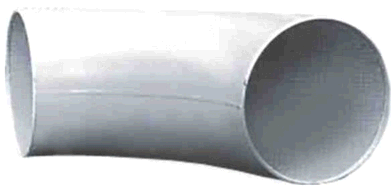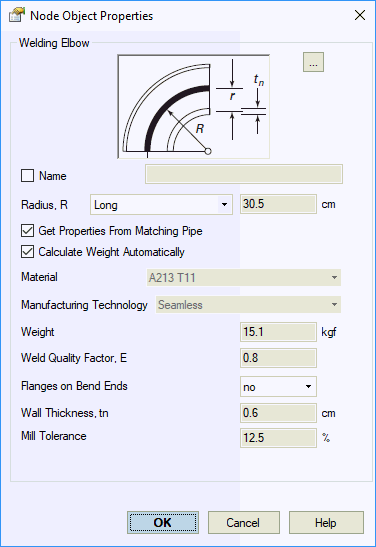



Figure 1
I-I - in-plane welds, II-II - out-of-plane welds
This bend type is manufactured from two sections with a longitudinal weld. Stress analysis treats forged elbows, induction bends, and welded elbows identically under ASME and EN standards.
Maximum bend angle is 90 degrees (More...). START-PROF performs wall thickness checks per Russian codes but not ASME for this bend type.

Property |
Description |
Name |
Element identifier. When checked, displays in 3D view. |
Radius, R |
Mean bend radius (0.5D) |
Get properties from matching pipe |
Import properties from connected pipe element. |
Calculate weight automatically |
Calculate weight as torus sector volume using adjoining pipe wall thickness. |
Weight |
Elbow weight including flanges (excluding insulation and fluid). Specify according to standards without overload factors. Fluid and insulation weights with overload factors are calculated automatically from adjoining pipes. When "Calculate weight automatically" is selected, weight is computed as torus sector volume. |
Longitudinal Weld Joint Efficiency Factor, E |
Longitudinal weld joint efficiency factor. More... |
Manufacturing technology |
For ASME B31.1, ASME B31.3, and DL/T 5366-2014, seamless pipe uses Wl=1.0. Electric-welded pipe Wl values are retrieved from database. More... For GOST 32388-2013, pipe properties are selected from different materials databases based on pipe type (seamless/welded). |
Calculate angle automatically |
Bend angle used for flexibility factor (k-factor) calculation in some codes. Enable by default for automatic calculation. Disable when modeling supports on split bends. Specify the full bend angle, not individual segment angles. |
Angle |
|
Material |
Material selection from materials database. |
Flange presence |
Flanges are rigid elements that prevent cross-section ovalization and affect flexibility and stress intensification factors.
|
Nominal wall thickness, S |
Nominal (actual) wall thickness. |
Mill tolerance, С1 |
Manufacturing
tolerance. More... |
Corrosion allowance, С2 |
Corrosion and wear allowance for wall thickness. More... |
Ovalization factor a, % |
Initial ovalization factor. More... |
Refresh SIF and k using FEA |
|
SIF |
To insert an elbow, select the desired node and use: Insert > Insert Bend > Welded Elbow
To view existing element properties:
Double-click the element in the 3D view
Select the element and click  toolbar icon
toolbar icon